Real strategies for increasing student enrollment are in real demand this academic year.
“The biggest challenge for most community colleges is reaching optimal enrollment,” says our CEO, Dr. Diane Walleser. “Not only are they dealing with the post-COVID changes, but they also have to contend with the ‘enrollment cliff.’”
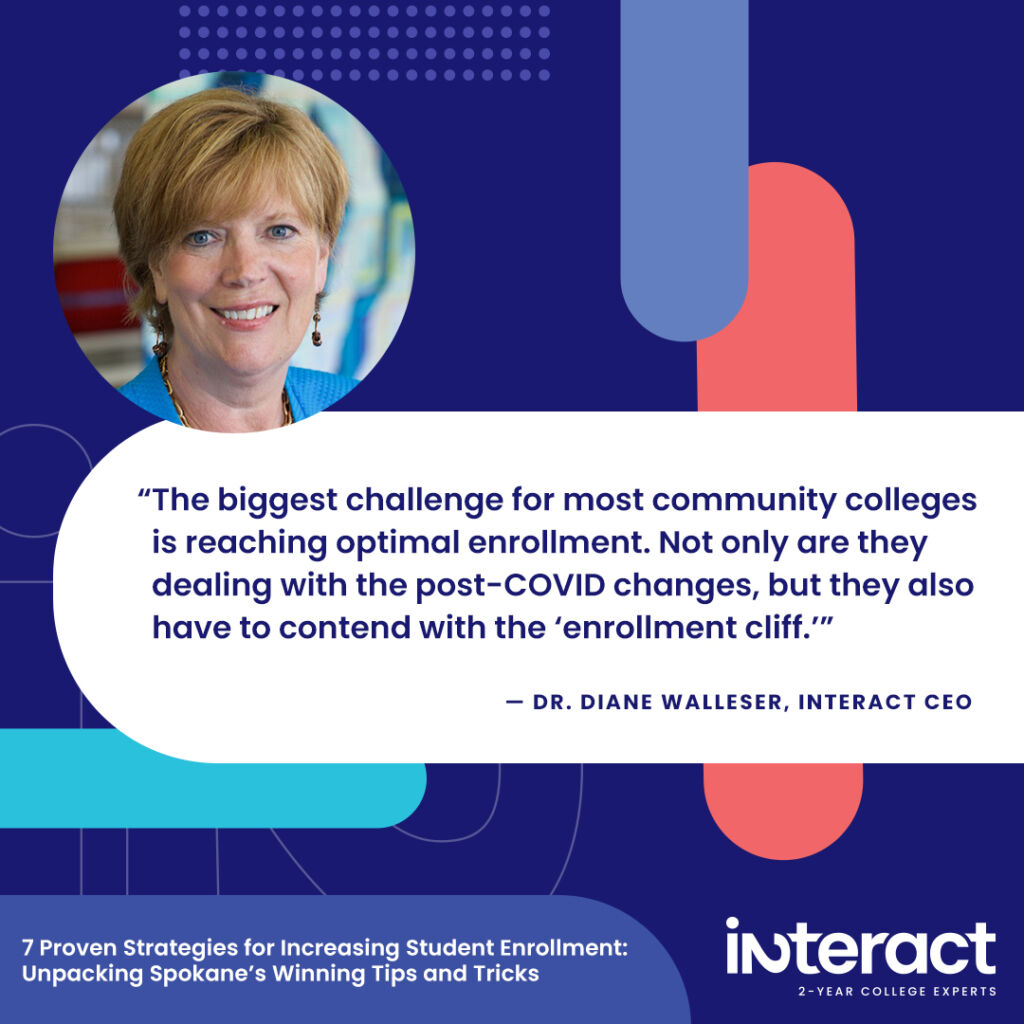
The enrollment cliff refers to the dwindling traditional college-aged population stemming from the 2008 Great Recession’s reduced birth rate. According to Best Colleges, “If you graph demographic projections, the precipitous descent resembles a cliff beginning in 2025. Over the succeeding four years, the number of 18-year-olds will decrease by 15%.”
With college admissions already in steady decline since 2012, including drops as high as 7% during the pandemic, this looming cliff means colleges need even stronger strategies for increasing student enrollment. So, keep reading for the top seven tips from work with our partners in Spokane to help you strategize this academic year and beyond!
1. One Size Does Not Fit All for Boosting Enrollment
No two schools are alike, meaning enrollment strategies cannot be cut-and-paste solutions. Just take Spokane Falls and Spokane Community Colleges, two two-year institutions in the Community Colleges of Spokane (CCS) system.
“They’re in the same city, but they have very different enrollment issues and serve different types of students,” says Walleser. “Moreover, they have different workflows and different personalities. Their solutions cannot be the same.”
Just because another college solved its enrollment woes with one strategy doesn’t mean it will work for your school. The secret is to find solutions that are as unique as your college.
2. Get Clear about the Enrollment Challenges
“Sometimes, administrators don’t have a clear idea about what the real problem is,” says Walleser.
Take the sister colleges in Spokane. They both had enrollment-related issues. But as Walleser says, “There are a million things you could do to address enrollment. The question is, what is the right thing your college should focus on?”
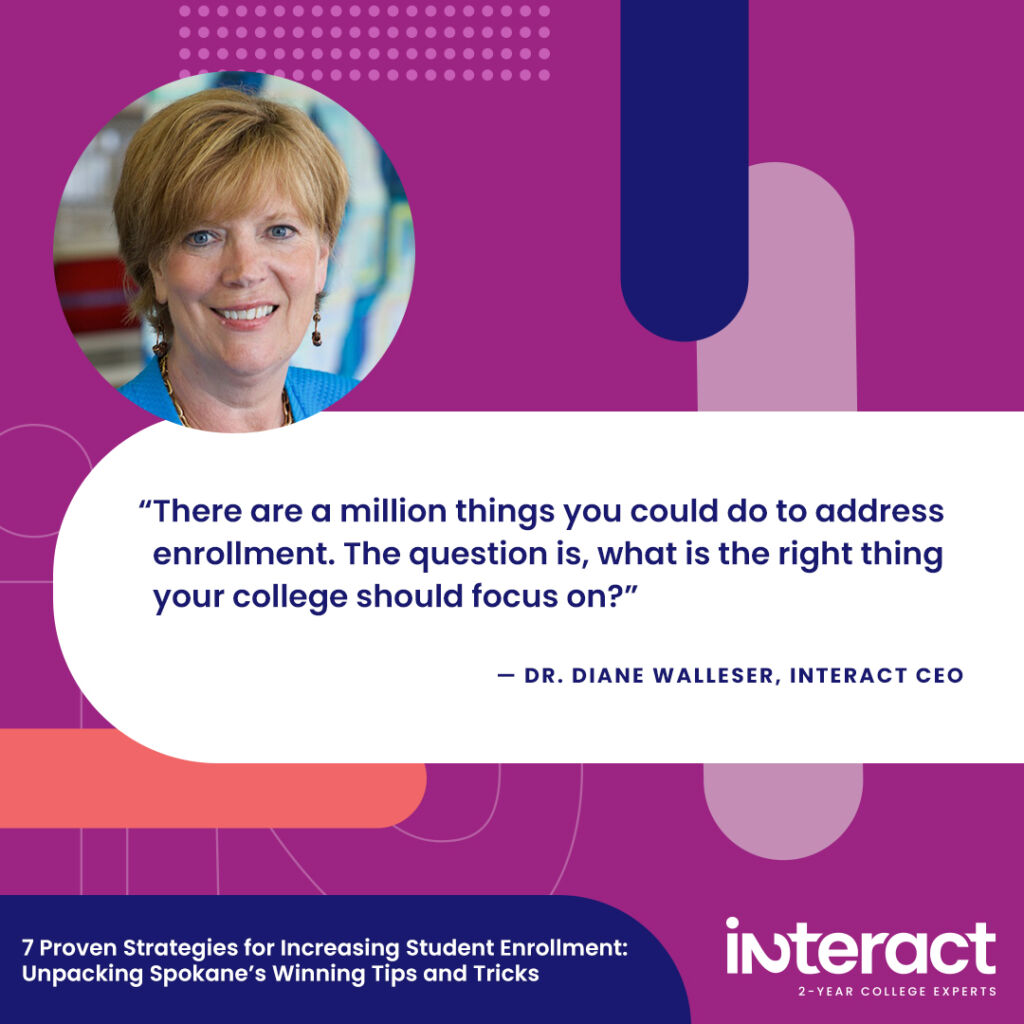
For CCS, one college focused on staff development and student communications, while the other worked hard to address pandemic-related changes and improve the student experience. But how did each college find its unique focus?
A robust discovery process was the answer for getting clear about enrollment challenges. For our Spokane partners, we helped gather and analyze feedback from each of their unique communities in Pain Point and Opportunity Scans. The process took a detailed look at where students were falling out of the onboarding funnel to help each college focus efforts.
“The Pain Point and Opportunity Scan process helps us identify the real challenges,” says Walleser. “We helped the CCS colleges figure out where to start and where they would gain the most traction for their efforts.”
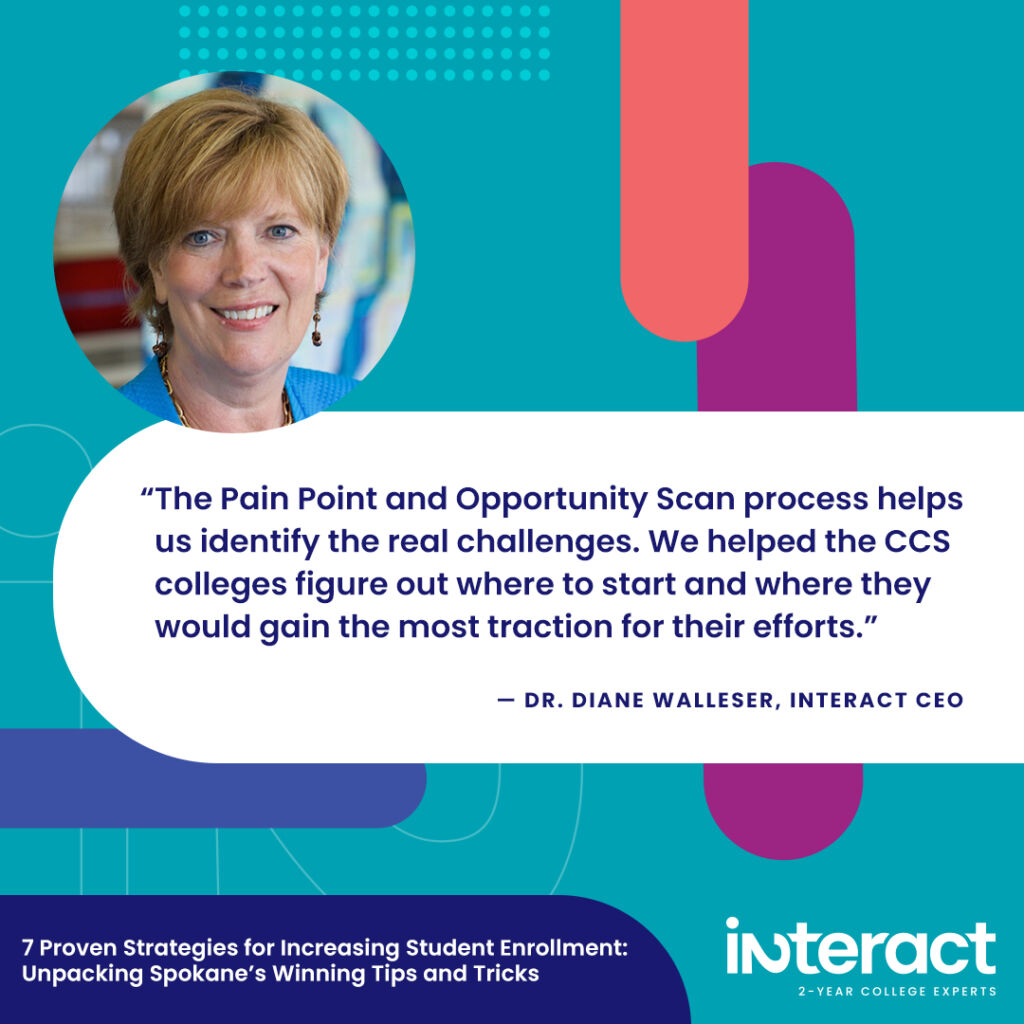
3. Clarity and Objectivity are Crucial Strategies for Increasing Student Enrollment
Our CEO says the secret to getting clear about your enrollment issues is to be as objective as possible when gathering information.
“If I talk to someone in student services, then folks from recruitment, then a faculty chair, they’re all going to have different points of view,” says Walleser. “The trick is to bring all those views together and get a bird’s-eye perspective on your challenges.”
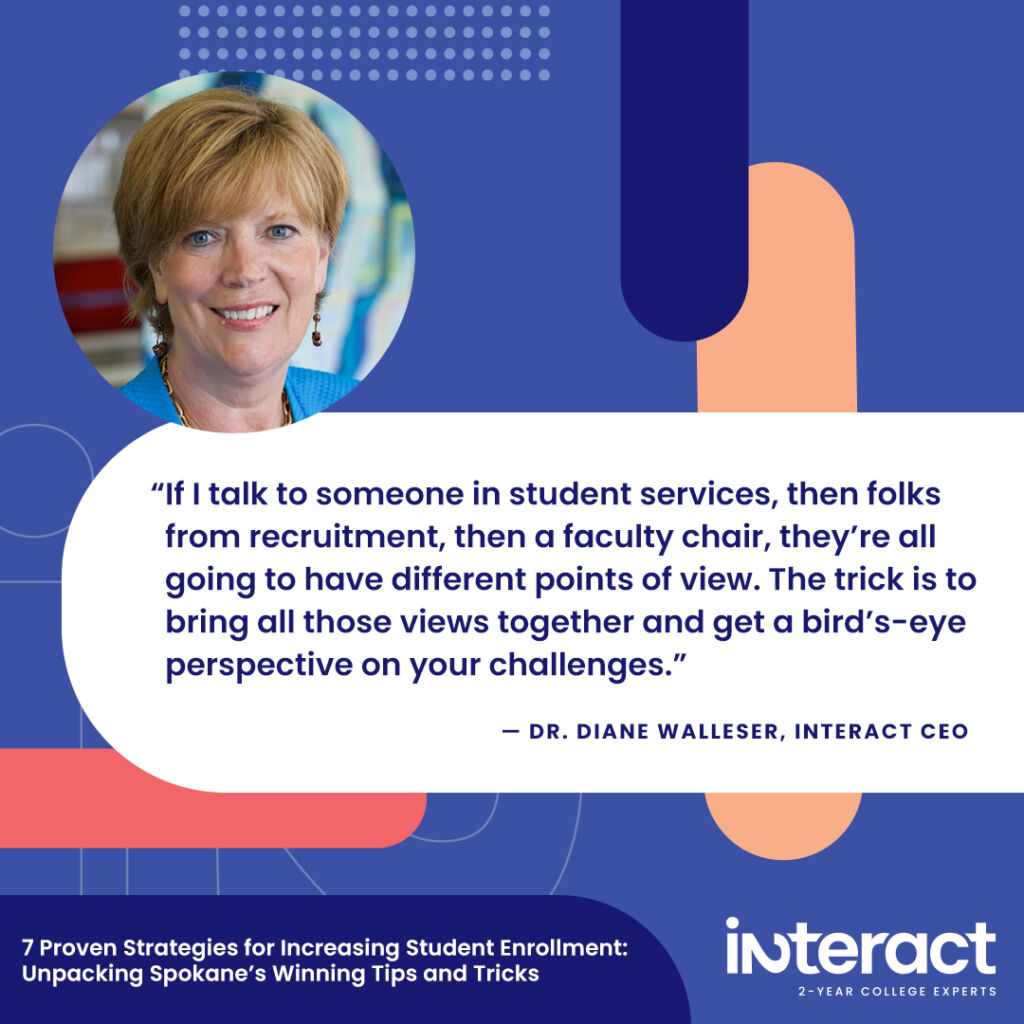
That’s why Interact helped survey faculty and staff across departments at the Spokane colleges. Leadership gained perspective on the problems, and the process helped connect departments and made them feel part of the solution.
“Just bringing people together and getting them to talk about the problems has helped bring clarity,” says Walleser, who facilitated scans at the colleges. “This process brings everyone together to overcome silos and create a unified team that can really pinpoint and solve problems.”
4. Distill Your Challenges into Key Focus Areas
It’s hard to prioritize when problems come at you all at once from many different angles. That’s why it’s essential to see how issues are connected and distill them into key focus areas.
“When our community college partners can see themes and bigger solutions — instead of getting bombarded every day with a list of problems — then they can focus on the biggest issues with the biggest return on investment,” says Walleser.
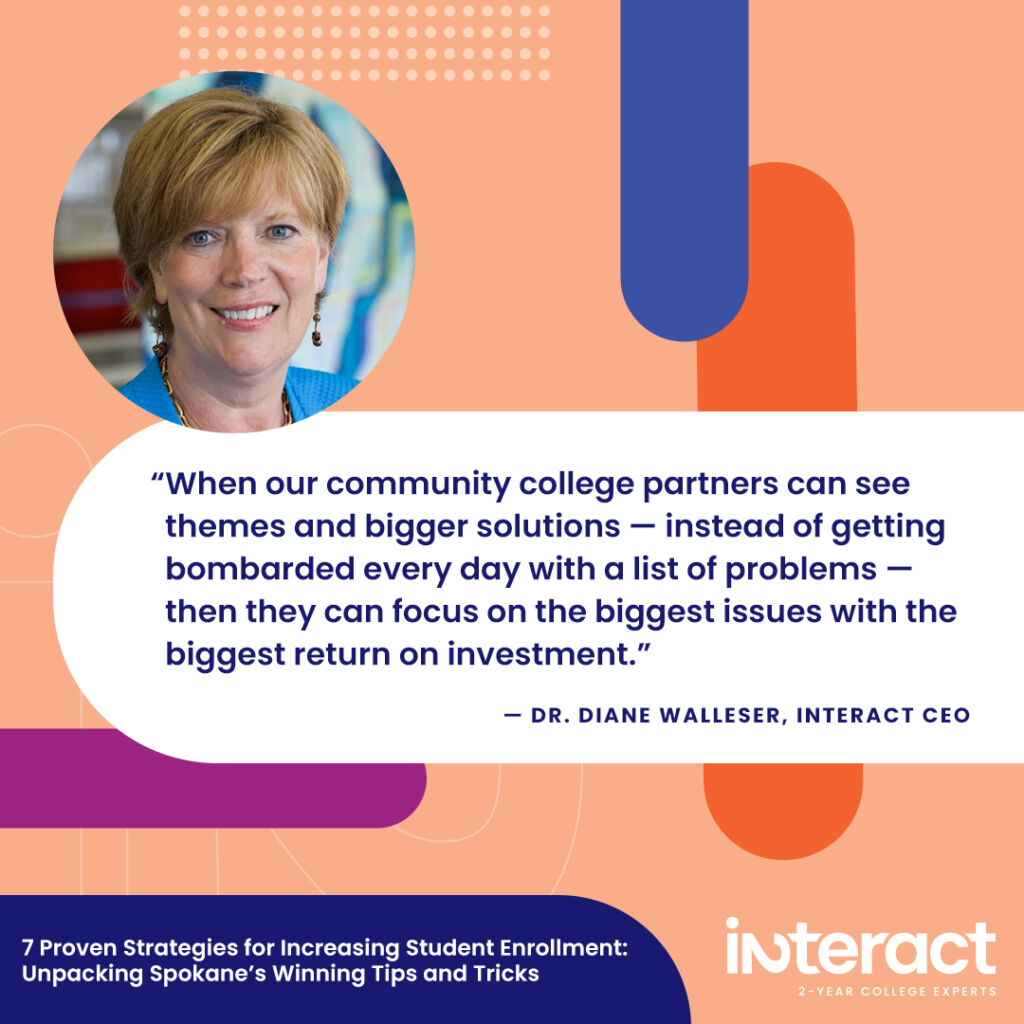
That’s why CCS started with an in-depth discovery process. Then, we boiled down the findings into key focus areas. With a 30,000-foot view, solutions came into sharp focus.
Once you have a comprehensive list of your students’ pain points, distill that information into key areas to help focus your strategies for increasing student enrollment.
5. Get to the Root of the Problem
It’s all too easy to mistake enrollment pipeline leaks as individual problems and fail to see how they are connected to larger issues.
For example, the Spokane colleges knew they could do more to bolster their enrollment, but their onboarding pipeline leaks seemed like a mystery. They knew they were losing students, but how? And why? So many times, smaller issues scattered throughout the pipeline are connected and can obscure larger problems. That’s why it’s critical to excavate, explore, and unearth the real source of the issue.
“The problem that presents itself is not always the root problem,” says Walleser. “Using a process like the pain point scan helps us dig deeper into what is really getting in the way of enrollment and retention.”

In the CCS scans, we asked questions like the following across departments:
- What obstacles keep students from coming to your college?
- What’s the biggest complaint you hear from students?
- On the other hand, what are some of the biggest complaints you hear from staff?
Says Walleser, “When you start asking questions like these, and you ask everyone on your teams, you discover what is really getting in the way of your enrollment.”
With so many ongoing and coordinated efforts across a college, it’s too easy to lose sight of the forest because of the trees. A pain point scan helps colleges gain perspective and spot the right path through the woods.
“The Pain Point and Opportunity Scan process gives colleges an inside view, allows us to take a deeper look, and helps us to prioritize,” says Walleser.
Speaking of setting priorities, that brings us to our next strategy for increasing student enrollment!
6. Work from the Top to the Bottom
The conversion rate from application to the first day of school is between 30 to 40% nationally. As you can see, there are a lot of leaks in the onboarding process. And if you can plug up your biggest ones, you’ll be able to boost your enrollment. But our CEO cautions that only a holistic, well-organized approach will work!
“Our founder, Dr. Pam Cox-Otto, says that if you go and stop one onboarding leak, it might start pushing out someplace else,” says Walleser. “The trick is knowing which leak you must fix first to strengthen your enrollment pipeline.”
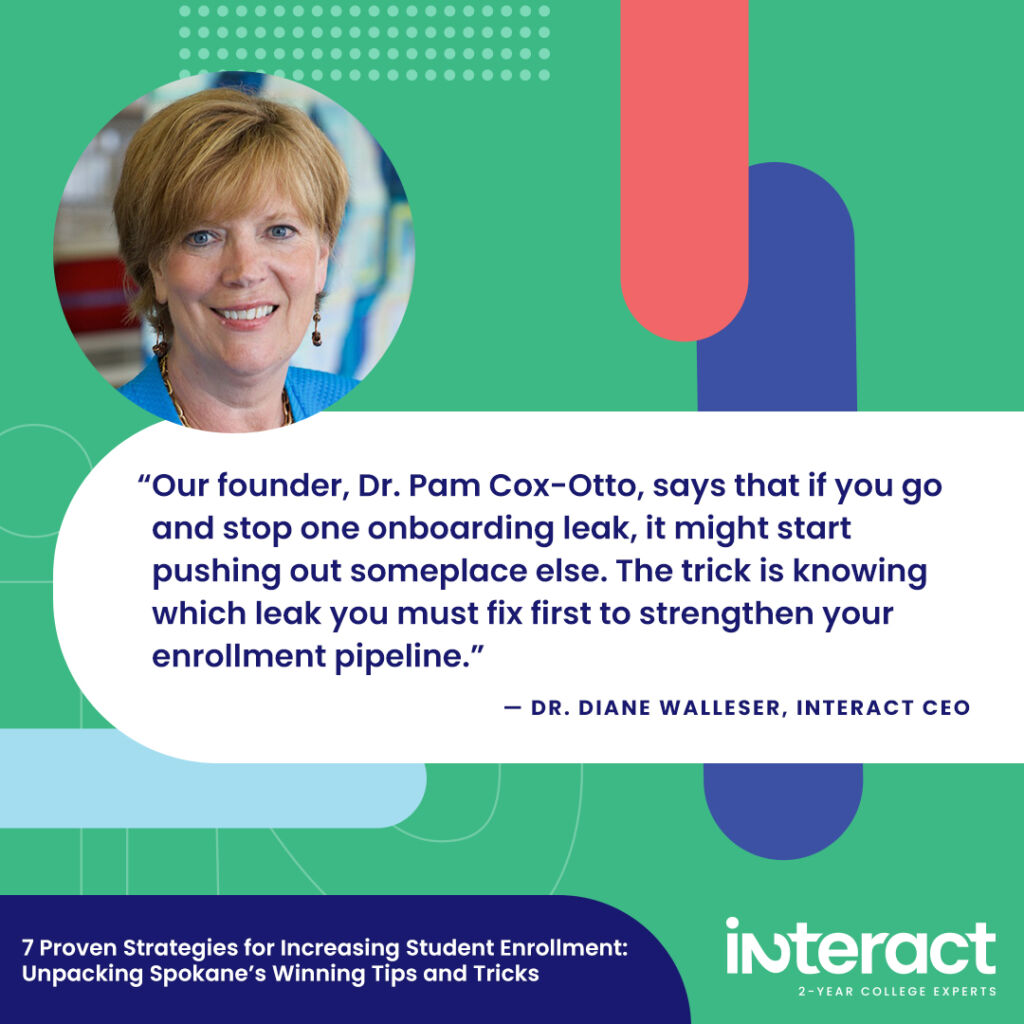
Sequencing changes in the right order is crucial. If you work first on the correct top-level issues in your onboarding pipeline, your changes can create a positive domino effect — instead of breaking the pipes.
“If you start working on those larger priorities and the biggest issues, a lot of the smaller issues go away on their own,” says our CEO. “That’s why the prioritization process is really important.”
So many different departments are involved in the onboarding process, from recruitment to admissions to financial aid. All too often, these teams don’t integrate seamlessly, and that causes enrollment leaks.
“How can you sequence your onboarding and retention changes to get those internal units to work together? How can you bring students easily to the next step and have the appropriate warm handoffs?” asks Walleser. “The process has to engage the whole community into solving the onboarding and retention issues.”
7. Put People Over Processes
The final secret to strategies for increasing student enrollment is putting your prospects above entrenched processes.

“Because our students have different and changing needs, our systems and processes need to respond accordingly,” says Walleser. “When we get stuck in routine structures and workflows in our colleges, we’re not always quick to make that process easier for all types of students.”
But what if changing a process isn’t possible? Say your college can’t change an old technology, causing onboarding hiccups for your prospects. The trick is to have a workaround: Improve communications with students to help them navigate hurdles.
“You can’t always fix the problem, but you can always improve the student experience. Try to make the process easier, clearly communicate the steps, and offer extra support,” says Walleser. “Putting your students before your processes requires staff to be innovative and look at different solutions.”
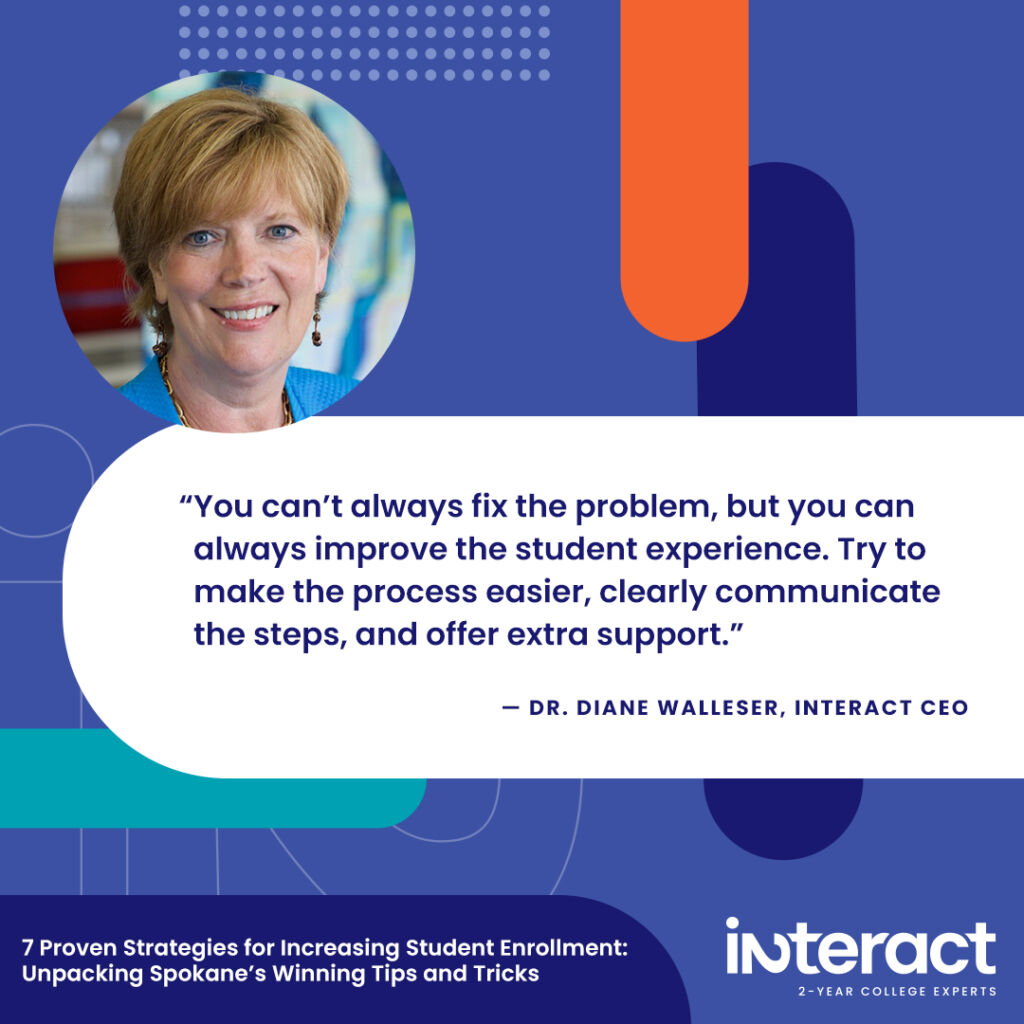
Ask Your Questions on Strategies for Increasing Student Enrollment!
In the end, both CCS colleges benefited from smoother processes and improved enrollments because they did the hard work:
- They found custom solutions to fix their colleges’ unique problems.
- A deep dive into a discovery process helped the colleges get clear about their challenges.
- Getting perspectives across different departments was crucial for objectivity.
- Then, they distilled their challenges down into key focus areas.
- It was also essential to dig deep, get to the root of the problem, and see how challenges were connected.
- Making a priority list ensured the colleges sequenced their efforts in the right order, creating a positive domino effect of change.
- And finally, the schools put their students above their entrenched processes, streamlining their pipeline for their prospects.
Want to find out how your college could do a similar process? Then catch our presentation at the next AACRAO Strategic Enrollment Management (SEM) Conference!
AACRAO SEM Conference: Hands-On Strategies for Increasing Student Enrollment
November 5-8, 2023, in Seattle, Washington

We’ll share insider knowledge, giving community colleges tools to move the dial on enrollment. If you’re not getting the enrollment and retention outcomes you want, this will be the perfect presentation for you!
Can’t make the AACRAO conference? Ask our experts your enrollment strategy questions in a free, 15-minute consultation. Let’s turn your challenges into new opportunities!



